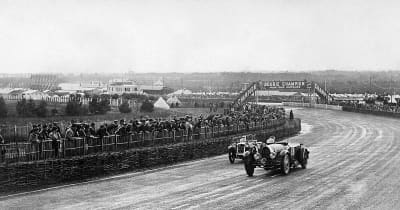 Racing cars take the Dunlop curve, as they compete in the 13th running of the 24 Hours of Le Mans motor race, 15th June 1935 at Le Mans. ©AFP
Racing cars take the Dunlop curve, as they compete in the 13th running of the 24 Hours of Le Mans motor race, 15th June 1935 at Le Mans. ©AFPHappy centenary to the oldest and longest running endurance car race, the 24 Hours of Le Mans. At the Circuit de la Sarthe in the city of Le Mans, France, teams of drivers compete to see who can do the most laps of the circuit in a single day.
The 2023 edition of the annual race will be the 91st time the event has taken place and will run from June 10-11. Last year’s race was won by a team of drivers including former F1 drivers Sébastien Buemi and Brendon Hartley, plus Ryō Hirakawa in a Toyota GR010 Hybrid who completed 380 laps with a 3 fastest qualifying lap: 24.408 seconds on a 13.626 km circuit. .
 Toyota Gazoo Racing’s Toyota GR010 was driven by Sébastien Buemi of Switzerland, Brendon Hartley of New Zealand and Ryo Hirakawa of Japan, in 2022Jeremias Gonzalez/Copyright 2022 The AP. All rights reserved
Toyota Gazoo Racing’s Toyota GR010 was driven by Sébastien Buemi of Switzerland, Brendon Hartley of New Zealand and Ryo Hirakawa of Japan, in 2022Jeremias Gonzalez/Copyright 2022 The AP. All rights reservedFor today’s Re-View, we travel all the way back to 1923 for the first time ever the race was held.
The Circuit de la Sarthe was already well established as a racing track by the early 1920s with the annual French Grand Prix having taken place since 1906. The track wound around the outskirts of the city of Le Mans with a key feature being the track being the long straight road which ran as far as the neighboring village of Mulsanne.
19 French manufacturers and one British manufacturer took part in the initial endurance race for a total of 37 teams. The original idea of the race was going to be a three part event. The eventual winner would be decided by whoever covered the longest distance through the Le Mans event and the next two events, an idea which was abandoned after 1928.
The cars competed in four categories, from “Very Large Engines” to “Small-sized Engines”. Some of the larger engined cars included the Lorraine-Dietrich B3-6 Torpédo body capable of reaching up to 145 km/h.
The opening race was a rain-soaked affair. The starting flag flew this day at 4:00 pm moments after the end of a hailstorm. The traditional start – abandoned in the 1960s – envisaged the cars lined up by engine size with the drivers in the pits. When the flag fell, the drivers ran to their cars to get in and start their engines. Despite the rain, most drivers didn’t even wear glasses at the time.
 The #10 Chenard-Walcker The Civil Engineering, June 16, 1923
The #10 Chenard-Walcker The Civil Engineering, June 16, 1923The track wet with rain and mud was increasingly dangerous as the race continued into the night. Several cars failed to make it through the darkness with stones puncturing fuel tanks and headlights.
However, when the next day dawned, the drivers continued with their herculean task. When the checkered flag flew again at 4.00pm the next day, 30 cars were still in motion.
Frenchmen André Lagache and René Léonard were the inaugural winners completing 128 laps in their Chenard-Walcker Type U3 15CV Sport. The fastest lap was set by the British team in a Bentley by Frank Clement who completed a lap in 9:39 seconds at an average speed of 107.33 km/h.




